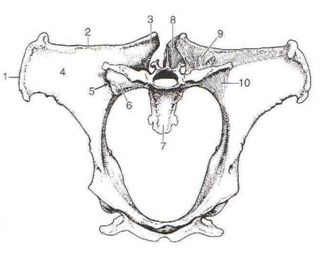Sacro-iliac joint Injection
As the name suggests the sacro-iliac joint is the joint between the sacrum (the name given to this area of the vertebral column) and the ilium, one of the three bones forming the pelvis of the horse. Unlike most other joints we may be familiar with this joint has very little joint space, and can be thought of as a combination of dense connective tissue and ligaments forming the junction between the two bones.
8,9,10, Various sacro-iliac ligaments. 3, tuber sacrale of the ilium. 5, sacro-iliac junction. 7, sacrum. 4, main body of ilium.
As the primary means by which the horse’s powerful hindquarter is joined to his axial skeleton, this joint, with its combination of ligaments and connective tissue is frequently subject to various degrees of tearing and strain. Importantly there are some major nerves, sciatic and gluteal, closely associated with the joint, and these frequently suffer from secondary inflammation.
When this happens the horse may present with a range of symptoms but commonly some of the following will be seen
- A lack of drive or impulsion from the hindquarter
- An inability to maintain topline muscle
- Appearance of a “roach back” or “hunters bumps”
- Varying degrees of pain on palpation of the area
- For ridden animals the feeling of occasional dipping or loss of one hind leg
- For pacers a reluctance to go straight on corners
- Discomfort or trembling when a hindleg is lifted
- Short term but no long lasting chiropractic relief
- Intermittent lameness
- Assymetry of the heights of the 2 tuber sacrales when viewed from behind.
- A tendency to hold back rigid and not exhibit normal lateral and dorsal flexion.
It should be obvious that the loss of topline muscle makes the horse structurally weaker in this area and so puts even further pressure on the sacro-iliac joint, so that we often have a vicious self-perpetuating cycle.
Rehabilitating a horse from a sacro-iliac injury involves a number of things, but among them will be
- Rest – always an important part of any soft tissue injury.
- Alleviation of the inflammation and in turn the pain (chronic lowgrade pain is a large cause of muscle loss)
- Re-establishment of topline muscle to give structural strength to the area.
- After initial rest a graded exercise program to build muscle and strength.
In order to both build and hold topline muscle the alleviation of inflammation and pain is essential. While systemic anti-inflammatories are quite useful in this regard, the direct injection into the joint and associated tissues of a combination of anti-inflammatories and neurolytics (drugs to alleviate nerve pain), is also of great assistance.
Injecting a structure approximately 6 inches below the surface of the skin has its challenges but with the advent of new and improved ultrasound that has greater depth of penetration, it is now possible to image this area and ensure accurate needle placement.
A, sacrum. B, medial surface of ilium. C, sacro-iliac junction


